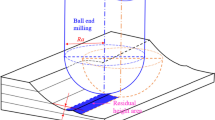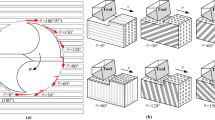Abstract
Machining of carbon fiber-reinforced polymers (CFRP) still remains a difficult procedure in the whole manufacturing process. One of the reasons is the cutting mechanism varies during machining, causing the inconsistency of surface integrity. This study intends to investigate the continuous variation of cutting mechanism and the induced cutting responses and damages. A novel experiment, with square and circular workpieces involved in cutting, was designed. A three-dimension micro-scale cutting simulation model was built. The experiment and simulation were combined to analyze the evolution and the correlation of cutting forces, machined surface roughness, sub-surface damage and the burr formation. The effects of rake angle and tool edge radius on chip formation and sub-surface damage were also presented. The conclusions are helpful to understand the damages generation during machining of CFRP.















Similar content being viewed by others

References
Cheng H, Gao J, Kafka OL, Zhang K, Luo B, Liu WK (2017) A micro-scale cutting model for UD CFRP composites with thermo-mechanical coupling. Compos Sci Technol 153:18–31
Calzada KA, Kapoor SG, Devor RE, Samuel J, Srivastava AK (2012) Modeling and interpretation of fiber orientation-based failure mechanisms in machining of carbon fiber-reinforced polymer composites. J Manuf Process 14(2):141–149
Gao C, Xiao J, Xu J, Ke Y (2016) Factor analysis of machining parameters of fiber-reinforced polymer composites based on finite element simulation with experimental investigation. Int J Adv Manuf Technol 83(5–8):1113–1125
Yan X, Reiner J, Bacca M, Altintas Y, Vaziri R (2019) A study of energy dissipating mechanisms in orthogonal cutting of UD-CFRP composites. Compos Struct 220:460–472
Liu H, Xie W, Sun Y, Zhang J, Chen N (2018) Investigations on micro-cutting mechanism and surface quality of carbon fiber-reinforced plastic composites. Int J Adv Manuf Technol 94(9–12):3655–3664
Abena A, Essa K (2019) 3D micro-mechanical modelling of orthogonal cutting of UD-CFRP using smoothed particle hydrodynamics and finite element methods. Compos Struct 218:174–192
Madhavan V, Lipczynski G, Lane B, Whitenton E (2015) Fiber orientation angle effects in machining of unidirectional CFRP laminated composites. J Manuf Process 20(SI2):431–442
Wang DH, Ramulu M, Arola D (1995) Orthogonal cutting mechanisms of graphite/epoxy composite .1. Unidirectional laminate. Int J Mach Tool Manu 35(12):1623–1638
Wang DH, Ramulu M, Arola D (1995) Orthogonal cutting mechanisms of graphite/epoxy composite .2. Multidirectional laminate. Int J Mach Tool Manu 35(12):1639–1648
Zitoune R, Collombet F, Lachaud F, Piquet R, Pasquet P (2005) Experiment-calculation comparison of the cutting conditions representative of the long fiber composite drilling phase. Compos Sci Technol 65(3–4):455–466
Wang XM, Zhang LC (2003) An experimental investigation into the orthogonal cutting of unidirectional fibre reinforced plastics. Int J Mach Tool Manu 43(10):1015–1022
Henerichs M, Voß R, Kuster F, Wegener K (2015) Machining of carbon fiber reinforced plastics: influence of tool geometry and fiber orientation on the machining forces. CIRP J Manuf Sci Technol 9:136–145
Wang F, Zhang B, Zhao M, Cheng D, Wang Z (2019) Evolution laws of fiber-matrix interface cracks in machining of carbon fiber reinforced polymer. Int J Adv Manuf Technol 101(1–4):963–977
Su Y, Jia Z, Niu B, Bi G (2017) Size effect of depth of cut on chip formation mechanism in machining of CFRP. Compos Struct 164:316–327
Voss R, Seeholzer L, Kuster F, Wegener K (2017) Influence of fibre orientation, tool geometry and process parameters on surface quality in milling of CFRP. CIRP J Manuf Sci Technol 18:75–91
Voss R, Seeholzer L, Kuster F, Wegener K (2019) Analytical force model for orthogonal machining of unidirectional carbon fibre reinforced polymers (CFRP) as a function of the fibre orientation. J Mater Process Technol 263:440–469
Li H, Qin X, He G, Jin Y, Sun D, Price M (2016) Investigation of chip formation and fracture toughness in orthogonal cutting of UD-CFRP. Int J Adv Manuf Technol 82(5–8):1079–1088
Niu B, Su Y, Yang R, Jia Z (2016) Micro-macro-mechanical model and material removal mechanism of machining carbon fiber reinforced polymer. Int J Mach Tools Manuf 111:43–54
Qi Z, Zhang K, Cheng H, Wang D, Meng Q (2015) Microscopic mechanism based force prediction in orthogonal cutting of unidirectional CFRP. Int J Adv Manuf Technol 79(5–8):1209–1219
Zenia S, Ben Ayed L, Nouari M, Delameziere A (2015) Numerical analysis of the interaction between the cutting forces, induced cutting damage, and machining parameters of CFRP composites. Int J Adv Manuf Technol 78(1–4):465–480
Usui S, Wadell J, Marusich T (2014) Finite element modeling of carbon fiber composite orthogonal cutting and drilling. In: Dornfeld D, Helu M (eds) Procedia CIRP 211-216
Rao GVG, Mahajan P, Bhatnagar N (2008) Three-dimensional macro-mechanical finite element model for machining of unidirectional-fiber reinforced polymer composites. Mater Sci Eng A Struct 498(1-2SI):142–149
Nayak D, Bhatnagar N, Mahajan P (2005) Machining studies of ud-frp composites part 2: finite element analysis. Mach Sci Technol 9(4):503–528
Iliescu D, Gehin D, Iordanoff I, Girot F, Gutierrez ME (2010) A discrete element method for the simulation of CFRP cutting. Compos Sci Technol 70(1):73–80
Rao GVG, Mahajan P, Bhatnagar N (2007) Machining of UD-GFRP composites chip formation mechanism. Compos Sci Technol 67(11–12):2271–2281
Kawabata S (1990) Measurement of the transverse mechanical-properties of high-performance fibers. J Text I 81(4):432–447
Hobbiebrunken T, Fiedler B, Hop M, Ochial S, Schulte K (2005) Microscopic yielding of CF/epoxy composites and the effect on the formation of thermal residual stresses. Compos Sci Technol 65(10):1626–1635
Jordan JL, Foley JR, Siviour CR (2008) Mechanical properties of Epon 826/DEA epoxy. Mech Time Depend Mater 12(3):249–272
Kaddour AS, Hinton MJ, Smith PA, Li S (2013) Mechanical properties and details of composite laminates for the test cases used in the third world-wide failure exercise. J Compos Mater 47(20-21SI):2427–2442
Zhang B, Wu Y, Yang Z, Wang X (2011) Experimental investigation of the longitudinal compressive strength of carbon fibres with a direct measurement system. Polym Polym Compos 19(6):477–483
Isbilir O, Ghassemieh E (2012) Finite element analysis of drilling of carbon fibre reinforced composites. Appl Compos Mater 19(3–4):637–656
Abena A, Soo SL, Essa K (2017) Modelling the orthogonal cutting of UD-CFRP composites: development of a novel cohesive zone model. Compos Struct 168:65–83
Acknowledgments
This work is supported by the Natural Science Foundation Guiding Program of Liaoning province [Grant numbers 2019-ZD-0235] and the Doctoral Foundation of SAU [Grant numbers 19YB13].
Author information
Authors and Affiliations
Corresponding author
Additional information
Publisher’s note
Springer Nature remains neutral with regard to jurisdictional claims in published maps and institutional affiliations.
Rights and permissions
About this article
Cite this article
Meng, Q., Cai, J., Cheng, H. et al. Investigation of CFRP cutting mechanism variation and the induced effects on cutting response and damage distribution. Int J Adv Manuf Technol 106, 2893–2907 (2020). https://doi.org/10.1007/s00170-019-04667-1
Received:
Accepted:
Published:
Issue Date:
DOI: https://doi.org/10.1007/s00170-019-04667-1



